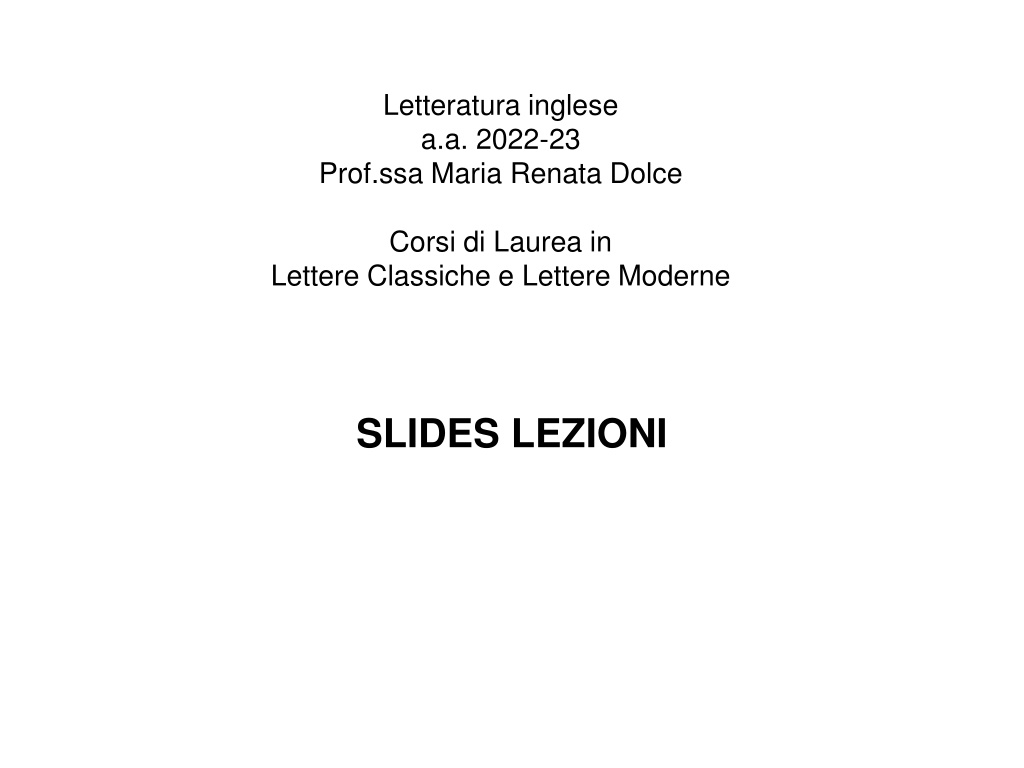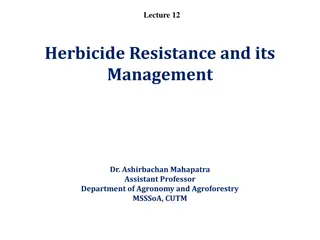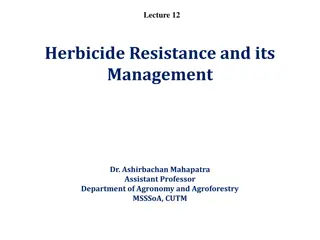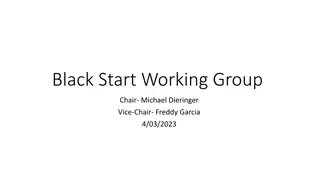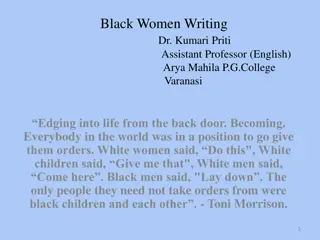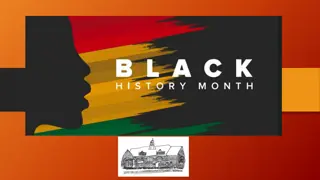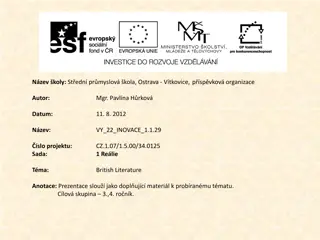Exploring Black British Literature: Identity, Diversity, and Resistance
Black British literature challenges traditional notions of Britishness, exploring themes of identity, freedom, and cultural diversity. It encompasses works from writers of Caribbean, Asian, and African origins, reflecting a heterogeneous body of texts that resists easy categorization. The development of Black British literature can be traced back to pioneer figures post-World War II, with a rich tradition that predates modern expressions. Labels are viewed as problematic due to the political nature of categorization in this literary landscape.
Download Presentation

Please find below an Image/Link to download the presentation.
The content on the website is provided AS IS for your information and personal use only. It may not be sold, licensed, or shared on other websites without obtaining consent from the author. Download presentation by click this link. If you encounter any issues during the download, it is possible that the publisher has removed the file from their server.
E N D
Presentation Transcript
Letteratura inglese a.a. 2022-23 Prof.ssa Maria Renata Dolce Corsi di Laurea in Lettere Classiche e Lettere Moderne SLIDES LEZIONI
Testi desame A. Gurnah, Sulla riva del mare M. Ali, Sette mari, tredici fiumi H. Kureishi, La parola e la bomba H. Kureishi, The Black Album (capitoli scelti) S. Rushdie, I versi satanici (capitoli scelti)
Black British literature Black British literature is produced by immigrants or their descendants who have become part of the country s social fabric (first and following generations). It poses a fundamental challenge to any general traditional understanding of what it means to be British It raises crucial questions about cultural identities and the concept of national and nationhood (various, shifting elements contribute to its making).
What is Black British literature? Contested definition literature in English produced in Great Britain by writers with Caribbean, Asian, African origins or with origins from the other countries which were part of the ex-British Empire over the years the preoccupation of much of this literature has been with the troubled quest for identity and freedom
Black British Literature: first expressions and its development Literary tradition which developed after the II World War (pioneer figures like S. Selvon and G. Lamming) But it includes texts which pre-date post-war works (earlier generations of black writers in Britain). They were published in the later eighteen century in the context of abolition campaigns and mainly in the form of life writing (the pioneer is O. Equiano with his autobiography Interesting Narratives, 1789)
The heterogenity of Black British literature Body of texts marked by a degree of heterogeneity that almost resists definition Texts by writers with African, South-Asian, Indo-Caribbean, African Caribbean and otherbackgrounds. Writers who belong to different generations and social classes, located in different geographical regions of Britain Different genres, texts written in different varieties of English Space not homogeneous, heterogeneity is one of its most relevant defining features
Labels are problematic! The question of categorization is always a political one: acts of inclusion and exclusion have political implications . The act of grouping texts conditions the significance and the meaning the texts attain in any given reading.
A Black British literature? A challenging but problematic definition D. Dabydeen, 1987: Black British literature refers to that created and published in Britain, largely for a British audience, by black writers either born in Britain or who have spent a major portion of their lives in Britain . But what of the term black ? Does black denote colour of skin or quality of mind? If the former, what does skin colour have to do with the act of literary creation? If the latter, what is black about black? What are the aesthetic structures that differentiate that expression from white expression? Though problematic the term is provocative and challenging. It implies the necessity of redefining and redressing the concepts of both Britishness and blackness, of reshaping space and identities.
The label black British literature: reductive and divisive? The label became current in the 1970s, designed to describe writing by authors based in Britain but with origins in former British colonies (Africa, Asia and the Caribbean). Many writers reject it: it suggests a marginalization, as if BB Lit were an appendage to mainstream literature. In the 1960s and 1970s it was a political label rather than a purely racial label: common experience of migration, alienation and discrimination combined with a subversive assertion of attachment to Britain. Now the label has lost some of its early scope and conventionally refers to authors of African and Caribbean descent Writers with Asian roots are today subsumed under the British Asian or Asian British banner. There s a growing gap between communities which were once bound by a shared status as racial and cultural outsiders, now increasingly divided often along religious lines (in particular after 9/11 and 7/7)
Black British: to recap The term came up in the later 1960s, in conjunction with black power movements, and gained wider currrency in the 70s: it became an ombrella term for the entire spectrum of non-white British citizens and their communities, all living under difficult conditions in a white-dominated society, as second class citizens (Buchi Emecheta 1976) The term was coined and used by the Caribbean Artists Movement in the second half of the 1960s. The movement bridged the transformation of Britain s West Indian community from one of exiles and immigrants to one of black British subjects. At its inception it was used to refer to distinct groups of West Indian migrants. Later it was used to include migrant groups from other parts of the world and to speak about people with African, Caribbean and Asian backgrounds (expecially South Asian, i.e. Indians and Pakistanis), sometimes including also East Asians e.g. Chinese. The term is not simply a marker of ethnic identity and/or cultural belonging. It refers to people of many different ethnicities and diverse cultures labelled Black for their social and political condition of marginalization and oppression. Marker of their contingent placing outside the social mainstream. Common experience of racism and marginalization (S. Hall, 1988) The term became very current in the 80s and 90s, but it was questioned and criticized for its broad, inclusive usage. Some critics have stressed the need to acknowledge cultural specificities and avoid too general terms which tend to homogenize the field. Beginning with the third millennium and the emphasis on cultural diversity, the usefulness of black British as a political term has been waning
Black British literature: thematic and formal characteristics Tradition of writing which promotes complexity and heterogeneity, alert to the politics of culture, race and gender The sense of exclusion and marginalization experienced by these writers has not given rise to a literature of victimization and retaliation The novelty is not just thematic but also formal: linguistic and structural inventiveness (starting with Selvon s novel) Disruption of tradition which goes beyond vocabulary and grammar. It concerns the shape of narrative itself. The text transgresses conventions Fragmented narrative which expresses the discontinuity and ambiguity at the heart of the black British condition
Black people in Britain: an historical survey The history of Black people in Britain used to be dated with the arrival of the SS Empire Windrush in June 1948 (steam ship with 492 Caribbean immigrants, recruited to rebuild the war-torn economy and join the English workers, expecially on London transport). Welcomed with official enthusiasm, with the tacit expectations that they would be guest workers who would eventually return home. As a matter of fact they determined an irreversible transformation of British society: it soon became clear that the immigrants had gone there to stay and make their new home in Britain. BUT Black presence in Britain goes back considerably longer and includes a wider spectrum than the Windrush generation. Middle of the eighteeen century: British involvement in the slave trade (growing number of Africans and Indians worked as servants in English households) Significant increase in black population. By 1770 this population is estimated to have numbered around 15,000 people, based largely in London and around ports involved in transatlantic trade such as Bristol and Liverpool.
William Hogarth and his paintings (second half XVIII century) Images of black servants can be found in paintings and on prints, textiles and ceramics of the period and provide rare visual evidence of the black British presence. The servant is often depicted as a marginal and isolated figure who is included merely to reflect the wealth and fashionable tastes of his 'owner'. Black Britons worked in a variety of professions; as sailors, shopkeepers, artisans, labourers, musicians, amongst others. The biggest employment sector for black populations was domestic service and a large number of black people worked as servants, butlers, valets and other domestic helps. Unlike their white counterparts, black domestic workers were largely unpaid and unable to voluntarily leave their employer. peddlers and street
The artist William Hogarth (1697-1764) often included black subjects in his satirical images of 18th-century life. It has been suggested that the figure of the servant reflects Hogarth's beliefs about the 'destabilising' influence of transatlantic trade. The presence of the servant, the monkey and the mahogany table of tea things all suggest a colonial source for the merchant's wealth. Look at he dehumanising silver 'slave collar' that the servant wears
King of Calypso Lord Kitchener singing London is the Place for me : https://www.rmg.co.uk/stories/windrush- histories/story-of-windrush-ship (from minute 0.45)
Immigration from colonial possessions after the II World War Windrush generation (Jamaican, Guyanese, Trinidadian migrants): beginning of large-scale postwar migration. During World War II West Indian soldiers had served in the British Army They considered their migration to Britain a return to the Mother Country . After the war Britain was in need of workers. The Nationality Act facilitated immigration. Britain actively recruited labour in the West Indies for the National Health Service, London Transport, and factories in the North. Very soon xenophobic responses and rescrictive immigration laws, immigration nearly impossible for black Commonwealth citizens.
Cultural diversity A society characterized by diversity recognizes that it is composed by individuals with different cultural backgrounds. They negotiate on equal terms the factors which they have in common and which bind them into a community
Minorities It implies that there is a more or less homogeneous majority society in which smaller distinct groups are either rejected, tolerated or integrated
MULTICULTURALISM: definition (1) Different people from different cultures co- exist but do not co-operate or interact. They may be aware of one another through different dress, religious observances, cuisine, etc., but they do not attempt to understand or relate to one another on a deeper level.
Multiculturalism: definition (2) M. refers to a state of communal diversity inside the territory of a state when people of various races, ethnicities, religious and cultural backgrounds live, work and trade together, participate in political life and are engaged in social and cultural interactions with the society while the society remains aware and fully accepts the different backgrounds of all its members. In this sense it is contrasted to the concept of a nation-state or assimilated state (homogeneous) where the inhabitants naturally share or are assimilated into sharing racial, cultural and religious backgrounds.
Multiculturalism It thus describes both - the demographic make-up of a country s population as an expression of the ideal of cross-cultural inter-ethnic harmony - and the public political initiatives that promote such an ideal.
Policy of Multiculturalism The policy of Multiculturalism (cultural mosaic) was first passed in Canada in 1972 by the Trudeau Government in order to allow everyone to retain his/her distinct culture while adapting to living and working in the new country. Canada together with Australia embraced the ideology of multiculturalism whereas the USA still preferred the melting pot policy of assimilation
Assimilation People give up their own cultural and linguistic identity and try to be as like members of their host society as possible
Critics of the multicultural model In our schools , multiculturalism means little more than teaching the kids a few bongo rhythms, how to tie a sari and so forth. In the police training programme, it means telling cadets that black people are so culturally different that they can t help making trouble. Multiculturalism is the latest token gesture towards Britain s blacks, and it ought to be exposed, like integration and racial harmony , for the sham of it (S. Rushdie, 1991)
Problems connected with multiculturalism and its policies A multicultural society lacks the cohesion to form a true community and could degenerate into parallel societies (See speech by Trevor Phillips) This affects social trust, erodes the host nation s distinct culture and the sense of belonging with a consequent retreat in individualism. People are less willing to co-operate with each other or make sacrifices on behalf of a community they no longer identify with. Thus in such a society no generally accepted basis on which shared ideals and values rest.
Monoculturalism Recently right-of-center governments in several European states have returned to an official monoculturalism (see Cameron s speech)
Renegotiation of the idea of culture No fictional purity but cultural diversity Nothing is ever completely other (foreign and unknown) World culture is not uniform but can be described as organized diversity , web of various local cultures (not necessarily anchored to a geographic territory), glocalities . Culture should become more flexible and serve the interests of all members of the community
Cultural diversity It involves interaction on a cross-cultural or inter-cultural basis (alternative to multiculturalism) It implies a potential common ground on which individuals can meet and interact.
Interculturalism It implies the existence of a network of horizontal relationships characterized by a dialogical and communicative afflatus which are the results of the coexistence of a plurality of cultures within one community.
Interculturalism In an intercultural context, cultures enter into dialogue confronting their differences. The other is not simply observed and described but enter into a dynamic relationship in the full respect of his/her difference In a pluralistic society equality and difference are strictly connected and unavoidable: everyone has the right to preserve one s own culture which is to be recognized with equal rights and dignity
B. Parekh, Rethinking multiculturalism (2000) Parekh argues that the emphasis on homogeneity in Western thought needs to be replaced by a broad-based humanism which recognizes cultural difference
Multiculturalism, interculturalism, transculturalism Melting pot (USA): metaphor that impies that all the immigrant cultures are mixed and amalgamated in order to be assimilated into American society (e pluribus unum). After its crisis in the 60 s the ideology of multiculturalism began to develop. Multiculturalism: coexistence of several distinct cultures within the same community, no assimilation Interculturalism: presence of relationships and exchanges between and within those cultures. Coexistence is extended to acceptance, comprehension and exchange. Transculturalism: overcoming of the traditional concept of culture as fixed. Idea of culture as always in process, costant transformation.Dialectical nature of cultural influences, no cultural barriers. It implies the reinventing of a commonly shared culture.
Policies of multiculturalism and interculturalism Effective in the fight against discrimination, in rejecting ethnocentrism, and in encouraging an ethic of recognition and respect of diversity.
However These models are based on a traditional concept of culture characterized by social homogeneity, they insist on difference and maintain polarity. Transculturalism, on the contrary, goes beyond by contesting cultural barriers and interrogating the notion of culture as exclusive, fixed and rooted in one single tradition
Transculturalism Term coined by the Cuban anthropologist Fernando Ortiz in 1940 indicating a transaction of a culture with another (concept based on Jos Marti s thinking that all American people were biologically and culturally m tis and therefore part of a dialectic with the other). T. as reinventing of a common culture based on the meeting and the intermingling of different peoples and cultures. T. can be envisaged as a new form of humanism based on the relinquishing of strong and fixed traditional identities and past heritages in favour of the breaking down of boundaries and a recognition of a culture of m tissage. One s identity is thus not onedimensional but defined and recognized in relation to the other, not singular but multiple
Imagining a new world Imagination and negotiation are essential for people to decide what they have in common and make them a community.
The role of literature and art And if it is a dream, that is the artist s job: to extent the reach of our imagination about the potential of real life and to dream our dream about how things could be if we had the will (Mike Phillips, 2004)
True cross-cultural interaction Cross-cultural interaction involves adaptation and compromise on both sides and ends in an agreement about what values all the members of society might share
Diaspora It literally means scattering , dispersal , traditionally used with reference to Jewish history (experience of living outside the Holy land, in foreign countries, in hostile host societies, under forms of oppression) Situation of displacement, of people forced to leave their homes, trying to cope under adverse circumstances Forced dispersion is caused by push factors like famine, war, enslavement, ethnic cleansing, political oppression (Gilroy, 1997) The history of colonialism, with centuries of slavery, violent dislocation,enforced migration, genocides, has engendered different forms of diaspora These diasporic movements have shaken up traditional forms and structures of belonging determining in-between positions and identities In order to counter their condition of displacement people cultivate a feeling of togetherness by means of a shared cultural memory. The missing homeland can be culturally compensated for and people find a basis of belonging (crucial role of literature) Nowadays when we talk about a diasporic people we refer basically to the community formed in the host country as a result of the phenomenon of dispersal and forced or volontary migration Imaginary homelands (Rushdie, 1991)
What is a diaspora? Diasporas are communities of people living together in one country who acknowledge that the old country a notion often buried deep in language, religion, custom or folklore always has some claim on their loyalty and emotions [ ] Robin Cohen, Global Diasporas: An Introduction, 1997
What is a diaspora? [ ] a member s adherence to a disporic community is demonstrated by an acceptance of an inescapable link with their past migration history and a sense of co- ethnicity with others of a similar background Robin Cohen, Global Diasporas: An Introduction, 1997
Diapora peoples and migrant peoples: generational differences Diaspora communities are composite, they are created out of the confluence of narratives of different journeys from the old country to the new which create the sense of a shared history. All diasporas are differentiated, heterogeneous, contested spaces (A. Brah, Cartographies of Diaspora, 1997). Diferences of gender, race, class, religion and laguage (as well as generational differences) make diaspora spaces dinamic and shifting, open to construction and reconstruction.
II generation of migrants They were born in Britain or arrived as young persons Their attachment to Britain is symbolized by their British passport Their birthplace is Britain, or their youth is spent there, British culture is of primary importance in their formative years The homelands left behind by their parents are less available to them, they have no direct memories (just in some cases of their journeys to those countries) Their parents homeland may be present through the parents memories and accounts The connections with the parents origins are tenuous But their attachment and belonging to Britain is problematic
S. Hall Cultural identity and diaspora
STUART HALL Jamaican-born British cultural theorist and academic (born 1932, Kingston, Jamaica died 2014, London), was a pioneer in the field of cultural studies, an interdisciplinary approach to the role of social institutions in the shaping of culture and the networks of meanings which individuals and groups use to make sense of and communicate with one another. Hall attained international stature in 1979 when he coined the term Thatcherism to describe the phenomenon of the broad (and ultimately long-lasting) political, economic, and cultural changes that would eventually be wrought by incoming prime minister Margaret Thatcher and her conservative supporters. He later chastised leftist thinkers underestimating Thatcherism s enduring popularity among disillusioned working-class people and for failing to counter the harshest elements of Thatcherism with a compelling alternative multiculturalism, environmentalism, and civil rights. and politicians for that would promote
STUART HALL Hall attended Jamaica College and in 1951 was awarded a Rhodes scholarship to study literature at Merton College, Oxford. He discovered that his dark skin and multiethnic, mixed-race childhood in Jamaica, where skin colour played such a central role in society that even his own parents did not allow him to associate with darker-skinned children) left him feeling out of place in England. He abandoned literature and began to develop a theory of encoding/decoding with which to analyze how those in power communicate with the masses through popular culture and how those on the receiving end interpret those messages. heritage (including his Hall was the founding editor (1960 61) of the New Left Review and a research fellow (1964 68), acting director (1968 72), and director (1972 79) at the University of Birmingham s innovative Centre for Contemporary Cultural Studies. In 1979 he joined the sociology faculty at the Open University, from which he retired in 1998.
STUART HALL From Obituary The Independent, 2014 (https://www.independent.co.uk/news/obituaries/professo r-stuart-hall-sociologist-and-pioneer-field-cultural- studies-whose-work-explored-concept-britishness- 9120126.html) The sociologist and cultural theorist Stuart Hall, who has died aged 82, was an intellectual giant and an inspirational figure in the field of sociology. He was one of the founders of what is now known as "British Cultural Studies", which Hall and his colleagues pioneered in the mid-1960s. Professor Henry Louis Gates of Harvard University called him "Black Britain's leading theorist of black Britain.". Hall saw Britain as a country which is forever battling, within itself and with other nations. "Britain is not homogenous; it was never a society without conflict," he said. "The English fought tooth and nail over everything we know of as English political virtues rule of law, free speech, the franchise." He noted sardonically that "the very notion of Great Britain's 'greatness' is bound up with empire. Euroscepticism and Little Englander nationalism could hardly survive if people understood whose sugar flowed through English blood and rotted English teeth." To sugar can also be added tobacco and cotton, as commodities which remain as a reminder of slave-trade Britain and its cultural legacy .
Stuart Hall, New Ethnicities https://contempoart.files.wordpress.com/2011 /08/stuart_hall_new_ethnicities.pdf Stuart Hall, Cultural Identity and Diaspora https://www.uibk.ac.at/anglistik/staff/davis/po stcolonial-essay.pdf
